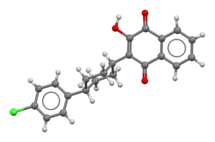Atovaquone
 | |
 | |
| Clinical data | |
|---|---|
| Trade names | Mepron |
| AHFS/Drugs.com | Monograph |
| MedlinePlus | a693003 |
| Routes of administration | By mouth |
| ATC code | |
| Legal status | |
| Legal status | |
| Pharmacokinetic data | |
| Elimination half-life | 2.2–3.2 days |
| Identifiers | |
| CAS Number | |
| PubChem CID | |
| DrugBank | |
| ChemSpider | |
| UNII | |
| KEGG | |
| ChEBI | |
| ChEMBL | |
| CompTox Dashboard (EPA) | |
| ECHA InfoCard | 100.158.738 |
| Chemical and physical data | |
| Formula | C22H19ClO3 |
| Molar mass | 366.84 g·mol−1 |
| 3D model (JSmol) | |
| Melting point | 216 to 219 °C (421 to 426 °F) |
| | |
Atovaquone, sold under the brand name Mepron, is a quinone antimicrobial medication for the prevention and treatment of Pneumocystis jirovecii pneumonia (PCP).[2]
Atovaquone is a chemical compound that belongs to the class of naphthoquinones. Atovaquone is a hydroxy-1,4-naphthoquinone, an analog of ubiquinone, with antipneumocystic activity.
Medical uses[]
Atovaquone is a medication used to treat or prevent:
- For pneumocystis pneumonia (PCP),[3][4] it is used in mild cases, although it is not approved for treatment of severe cases.
- For toxoplasmosis,[5] the medication has antiparasitic and therapeutic effects.
- For malaria, it is one of the two components (along with proguanil) in the drug Malarone. Malarone has fewer side effects and is more expensive than mefloquine.[6] Resistance has been observed.[7]
- For babesia, it is often used in conjunction with oral azithromycin.[8]
Trimethoprim/sulfamethoxazole (TMP-SMX, Bactrim) is generally considered first-line therapy for PCP (not to be confused with Sulfadiazine+pyrimethamine which is first line for toxoplasmosis). However, atovaquone may be used in patients who cannot tolerate, or are allergic to, sulfonamide medications such as TMP-SMX. In addition, atovaquone has the advantage of not causing myelosuppression, which is an important issue in patients who have undergone bone marrow transplantation.
Atovaquone is given prophylactically to kidney transplant patients to prevent PCP in cases where Bactrim is contraindicated for the patient.[medical citation needed]
Malaria[]
Atovaquone, as a combination preparation with proguanil, has been commercially available from GlaxoSmithKline since 2000 as Malarone for the treatment and prevention of malaria.
Veterinary use[]
Atovaquone is used in livestock veterinary cases of babesiosis in cattle, especially if imidocarb resistance is a concern.[9]
Research[]
COVID-19[]
Preliminary research found that atovaquone could inhibit the replication of SARS-CoV-2 in vitro.[10] Clinical trials of atovaquone for the treatment of COVID-19 are planned.[11][12][when?]
Atovaquone has also been found to inhibit human coronavirus OC43 and feline coronavirus in vitro.[13]
References[]
- ^ "Wellvone 750mg/5ml oral suspension - Summary of Product Characteristics (SmPC)". (emc). 28 November 2019. Retrieved 18 September 2020.
- ^ "Atovaquone Oral SUSPENSION- atovaquone suspension". DailyMed. 10 December 2019. Retrieved 18 September 2020.
- ^ Hughes W, Leoung G, Kramer F, et al. (May 1993). "Comparison of atovaquone (566C80) with trimethoprim-sulfamethoxazole to treat Pneumocystis carinii pneumonia in patients with AIDS". N. Engl. J. Med. 328 (21): 1521–7. doi:10.1056/NEJM199305273282103. PMID 8479489.
- ^ Dohn MN, Weinberg WG, Torres RA, et al. (August 1994). "Oral atovaquone compared with intravenous pentamidine for Pneumocystis carinii pneumonia in patients with AIDS. Atovaquone Study Group". Ann. Intern. Med. 121 (3): 174–80. doi:10.7326/0003-4819-121-3-199408010-00003. PMID 7880228.
- ^ Djurković-Djaković O, Milenković V, Nikolić A, Bobić B, Grujić J (December 2002). "Efficacy of atovaquone combined with clindamycin against murine infection with a cystogenic (Me49) strain of Toxoplasma gondii". J. Antimicrob. Chemother. 50 (6): 981–7. doi:10.1093/jac/dkf251. PMID 12461021.
- ^ Malarone: New Malaria Medication With Fewer Side-effects Archived May 14, 2006, at the Wayback Machine
- ^ Färnert A, Lindberg J, Gil P, et al. (March 2003). "Evidence of Plasmodium falciparum malaria resistant to atovaquone and proguanil hydrochloride: case reports". BMJ. 326 (7390): 628–9. doi:10.1136/bmj.326.7390.628. PMC 151974. PMID 12649236.
- ^ Krause PJ, Lepore T, Sikand VK, et al. (November 2000). "Atovaquone and azithromycin for the treatment of babesiosis". N. Engl. J. Med. 343 (20): 1454–8. doi:10.1056/NEJM200011163432004. PMID 11078770.
- ^ Vial, Henri J.; Gorenflot, A. (2006). "Chemotherapy against babesiosis". Veterinary Parasitology. Elsevier. 138 (1–2): 147–160. doi:10.1016/j.vetpar.2006.01.048. ISSN 0304-4017.
- ^ Farag A, Wang P, et al. (May 2020). "Identification of Atovaquone, Ouabain and Mebendazole as FDA-Approved Drugs Targeting SARS-CoV-2". chemRxiv (preprint). doi:10.26434/chemrxiv.12003930.v4. Retrieved 20 June 2020.
- ^ "Atovaquone and Azithromycin Combination for Confirmed COVID-19 Infection". ClinicalTrials.gov. Retrieved 22 October 2020.
- ^ "Atovaquone for Treatment of COVID-19". ClinicalTrials.gov. Retrieved 22 October 2020.
- ^ Wang CW, Peng TT, et al. (August 2020). "Repurposing old drugs as antiviral agents for coronaviruses". Biomedical Journal. 43 (4): 368–374. doi:10.1016/j.bj.2020.05.003. Retrieved 22 October 2020.
Further reading[]
- Kessl JJ, Hill P, Lange BB, Meshnick SR, Meunier B, Trumpower BL (January 2004). "Molecular basis for atovaquone resistance in Pneumocystis jirovecii modeled in the cytochrome bc(1) complex of Saccharomyces cerevisiae". J. Biol. Chem. 279 (4): 2817–24. doi:10.1074/jbc.M309984200. PMID 14576156.
External links[]
- "Atovaquone". Drug Information Portal. U.S. National Library of Medicine.
| Wikimedia Commons has media related to Atovaquone. |
- Antimalarial agents
- Antiprotozoal agents
- 1,4-Naphthoquinones
- Chloroarenes
- Hydroxynaphthoquinones
